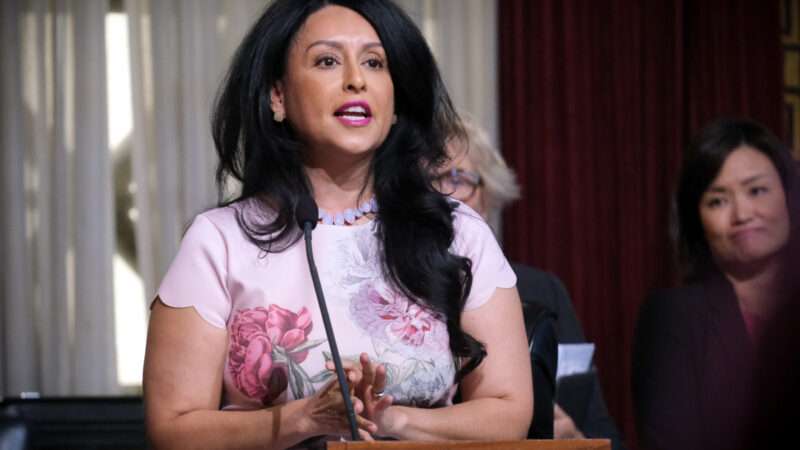The rampant cable news attention seeking and kayfabe committee hearings that characterize politics today have an ideologically diverse set of pundits yearning for a return of the “smoke-filled room.” There, the argument goes, politicians could hash out policy in private, frank conversations away from all the bad incentives created by TV cameras and records requests.
“Sometimes,” wrote Jonathan Rauch in 2015, “the only thing wrong with smoke-filled rooms is the smoke.”
The intensifying scandal surrounding three Los Angeles City councilmembers caught on a surreptitious recording making racist remarks during one such “frank” conversation shows how unwarranted that romance for smoke-filled rooms really is.
On Sunday, the Los Angeles Times published a leaked October 2021 conversation between Councilmembers Nury Martinez, Kevin De León, Gil Cedillo, and labor leader Ron Herrera about redrawing city council district boundaries.
In it, Martinez is heard describing fellow Councilmember Mike Bonin as a “little bitch” while using a Spanish term to describe his black child as a monkey in need of a disciplinary “beatdown.” She also goes after Los Angeles County District Attorney George Gascón, saying “fuck that guy…he’s with the blacks.” De León accused Bonin of using his child like an accessory—comparing him to Martinez’s Louis Vuitton purse.
The racist nature of the remarks has led to widespread calls for the three councilmembers to resign. On Tuesday, President Joe Biden, via White House Press Secretary Karine Jean-Pierre, said all three needed to go. On Wednesday, California Attorney General Rob Bonta announced a state investigation into the redistricting process.
Last night, Martinez bowed to the pressure and announced that she would resign. De León and Cedillo are still on the council.
One question raised by this scandal is whether Los Angeles residents and voters are better off knowing the candid thoughts of their representatives.
The people calling for the councilmembers to resign certainly think this is important and useful knowledge. For them, it’s determinative of whether they think a public figure can reliably serve in their role or not.
But for the smoke-filled room supporters on the left, right, and center, our ability to peer into backroom deals between politicians is making our politics worse, not better.
“Lying, cheating, and stealing are certainly more difficult when the world is watching. But so are dickering, floating trial balloons, being candid, and working out complex deals,” said Rauch in his 2015 book Political Realism, arguing for a return to a more transactional politics. Closed-door negotiations, he argued, give politicians “more freedom to explore policy options and multidimensional, integrative solutions.”
Blogger Matt Yglesias’ 2016 essay “Against Transparency” went even further with this idea by arguing against “input disclosure”—a wonky term that refers to transparency around the political back-and-forth that produces policy.
“The fundamental problem with input disclosure is that in addition to serving as a deterrent to misconduct, it serves as a deterrent to frankness and honesty,” said Yglesias. “Rather than saying what they mean, participants will be saying what they want to be seen as saying. Actual decision-making will take on the flavor of a stage-managed press conference, where ideas are sanitized and no mistakes are confessed.”
So long as we still have output disclosure—i.e. transparency around the end policy produced by all that private politicking—voters can still make informed decisions about their government, says Yglesias.
It’s an idea that has proven pretty sticky. People have used some version of it to argue for removing cameras from congressional committee hearings or even ending presidential primaries.
The common thread of all these arguments is that politicians are made worse by having to do their business in public and remain appealing to voters at each step of the way. Better to have a backroom dealer subject to the occasional election than a political performer who’s always on for the cameras, the thinking goes.
Revelations about how the three Los Angeles councilmembers behave when they think no one is listening suggest that cameras aren’t as damaging as we might think, and that backroom deals can be pretty dirty indeed.
There is, after all, a heavily public component of the Los Angeles redistricting process. A 21-member redistricting commission made up of members of the public holds hearings, logs their ex parte negotiations, and ultimately draws up a recommended map for the city council to consider.
This isn’t an apolitical process, but its structure creates at least a stab at transparency and public spiritedness. The smoke-filled room advocates would seemingly argue that this is only making Los Angeles’ governance worse. Better to let professional politicians hash out redistricting largely in private, where they can candidly acknowledge political realities and cut deals.
We now have a great example of what that actually looks like. Freed from input disclosure, Martinez and her colleagues let fly all sorts of horrible and disparaging remarks about their colleagues and constituents while they tried to carve up the city council districts to suit their interests. It’s not a pretty thing to listen to. More to the point, I’m not sure what value it added to the redistricting process in L.A.—other than potential criminality.
Obviously, Yglesias and Rauch, and other smoke-filled room advocates, aren’t defending the comments made by L.A.’s embattled/disgraced councilmembers.
But it’s hard to see how a politics that involves more smoke-filled rooms and less public disclosure would guard against such ugliness. We can’t rely on anonymous whistleblowers making recordings of every racist, horse-trading conversation, after all.
The smoke-filled room defenders aren’t wrong that shining light on everything has its downsides. Purely performative politics produces plenty of its own problems.
Striking the right balance mostly seems to be a task for people who want the government to do a lot of things. The smaller and less impactful city hall is, the less we need to worry that it’s run by bad people.
Indeed, one idea floated in the wake of the council scandal is reducing councilmembers’ discretion over real estate development and contracting in their districts. That would lessen their incentive to fight over territory and voters. That would, in turn, potentially lead to less corruption, and more willing transparency.
Until that happens, I’d argue we’re better off with a system that forces politicians to do their dirty work in public. Output disclosure isn’t enough.
“The theory says that sunshine is the best disinfectant, but people also need a dark room to sleep in at night if they’re going to function properly,” writes Yglesias. This week’s leaked audio reveals the room that L.A. politicians sleep in is pretty dark indeed.
The post L.A.'s Leaked City Council Tape Reminds Us Why 'Smoke-Filled Rooms' Are Bad appeared first on Reason.com.
from Latest https://ift.tt/MPQ0fNA
via IFTTT





